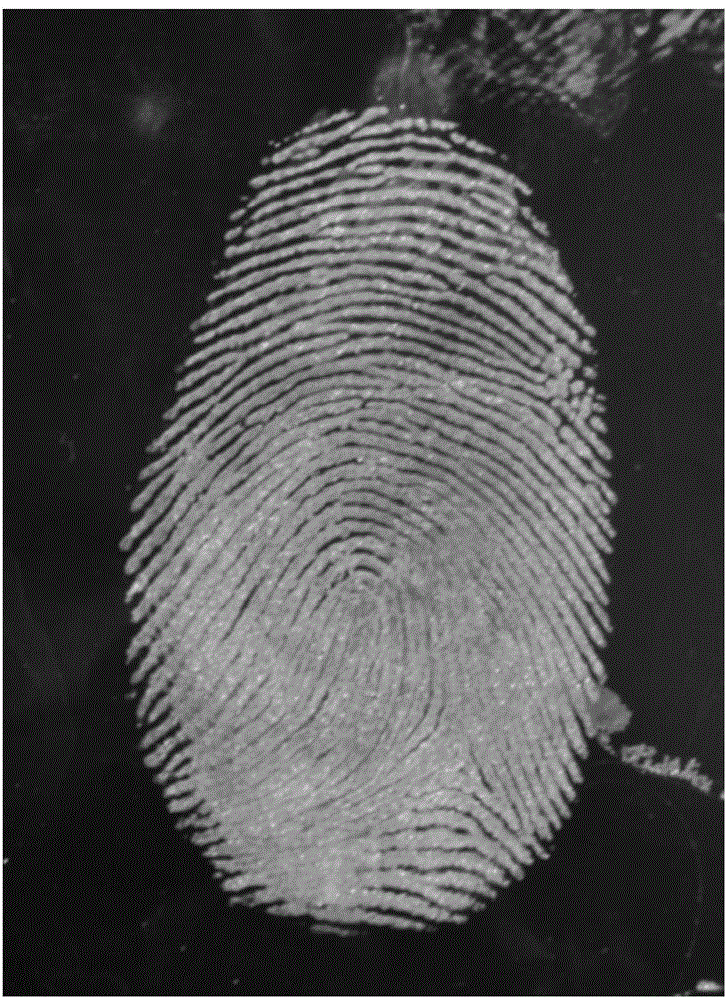Two-step latent fingerprint manifesting method based on nano-particles
A nanoparticle and latent fingerprint technology, which is applied in the fields of human identification, medical science, and diagnosis by using light, can solve the problems of poor display effect, poor sensitivity, and large influence of background factors, and achieve high sensitivity and high contrast fluorescence characteristics , the effect of easy operation
- Summary
- Abstract
- Description
- Claims
- Application Information
AI Technical Summary
Problems solved by technology
Method used
Image
Examples
Embodiment 1
[0043] The preparation method of nanoparticle display liquid:
[0044] (1) take by weighing 3g nano-alumina with balance, put into Erlenmeyer flask;
[0045] (2) Add 100ml of distilled water to the Erlenmeyer flask, then add 0.2ml of N-octyltrimethoxysilane, and mix well;
[0046] (3) Stir in a magnetic stirrer with a rotation speed of 400 rpm, reflux in a water bath at 20°C for 1 hour, and fully react;
[0047] (4) Remove the supernatant from the reacted solution, wash it with distilled water for several times, and finally add stabilizer distilled water to make a nano-alumina developing solution.
[0048] Preparation of organic fluorescent dye colorants:
[0049] (5) Weigh 0.2g of cationic yellow with a balance, add 100ml of methanol to make cationic yellow dye.
[0050] Appearance method:
[0051] (6) Shake the nano-aluminum sesquioxide solution prepared by step (4) into milk;
[0052] (7) Immerse the white ceramic material suspected to have fingerprints in the liquid a...
Embodiment 2
[0056] (1) take by weighing 4g nano-alumina with balance, put into Erlenmeyer flask;
[0057] (2) Add 150ml of distilled water to the Erlenmeyer flask, then add 1ml of N-octyltrimethoxysilane, and mix well;
[0058] (3) Stir in a magnetic stirrer with a rotation speed of 600 rpm, reflux in a water bath at 30°C for 1.5 hours, and fully react;
[0059] (4) Remove the supernatant from the reacted solution, wash it with distilled water for several times, and finally add stabilizer distilled water to make a nano-alumina developing solution.
[0060] Preparation of organic fluorescent dye colorants:
[0061] (5) Weigh 0.4g of Cationic Yellow with a balance and add 100ml of methanol to make Cationic Yellow dye.
[0062] Appearance method:
[0063] (6) Shake the nano-aluminum sesquioxide solution prepared by step (4) into milk;
[0064] (7) Immerse the glass of the material to be inspected that is suspected to have fingerprints in the liquid and shake it continuously, and the fing...
Embodiment 3
[0068] (1) Take by weighing 5g nano-aluminum sesquioxide with balance, put into Erlenmeyer flask;
[0069] (2) Add 200ml of distilled water to the Erlenmeyer flask, then add 2ml of N-octyltrimethoxysilane, and mix well;
[0070] (3) Stir in a magnetic stirrer with a rotation speed of 800 rpm, reflux in a water bath at 60°C for 2 hours, and fully react;
[0071] (4) Remove the supernatant from the reacted solution, wash it with distilled water for several times, and finally add stabilizer distilled water to make a nano-alumina developing solution.
[0072] Preparation of organic fluorescent dye colorants:
[0073] (5) Weigh 0.5g of cationic yellow with a balance, add 100ml of methanol to make a cationic yellow dye.
[0074] Appearance method:
[0075] (6) Shake the nano-aluminum sesquioxide solution prepared by step (4) into milk;
[0076] (7) Immerse the aluminum foil of the material to be inspected that is suspected to have fingerprints in the liquid and shake it continuo...
PUM
 Login to View More
Login to View More Abstract
Description
Claims
Application Information
 Login to View More
Login to View More - R&D
- Intellectual Property
- Life Sciences
- Materials
- Tech Scout
- Unparalleled Data Quality
- Higher Quality Content
- 60% Fewer Hallucinations
Browse by: Latest US Patents, China's latest patents, Technical Efficacy Thesaurus, Application Domain, Technology Topic, Popular Technical Reports.
© 2025 PatSnap. All rights reserved.Legal|Privacy policy|Modern Slavery Act Transparency Statement|Sitemap|About US| Contact US: help@patsnap.com



